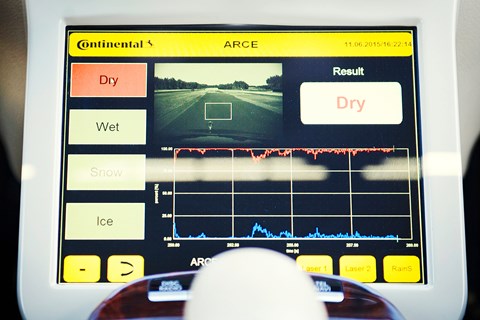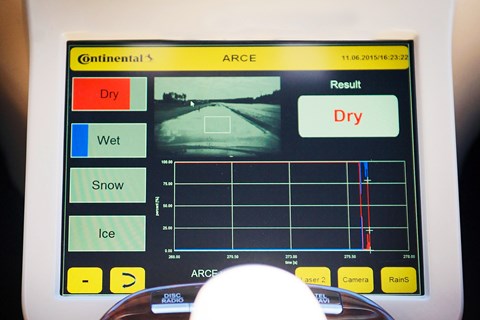► CAR’s weather tech test
► Does the tech work?
► Road Condition Observer
We’ve all been there: a dark winter night, temperature around zero, driving on an unfamiliar country lane, when suddenly the wheels lose traction and, for one heart-in-the-mouth instant before the ESC kicks in to correct the slide, you’re heading for a tree. Black ice and other weather-related hazards are real killers.
But what if your car knew there was a chance of black ice on that road and had warned you and prepared the car’s safety systems in anticipation of such a drama? Engineers at tech supplier Continental are developing Road Condition Observer.
It’s made possible by the ever increasing sophistication of sensors and cameras, combined with the ability to stream data in a car. That, and the engineers’ ability to write sophisticated algorithms.
Camera images from the front of the car are cross referenced with tyre behaviour and vehicle dynamics data from the ESC, as well as local and regional weather data, making it possible to calculate the grip co-efficient of the road surface.
The initial input is from a digital weather map downloaded from the closest meteorological station, determined by the car’s GPS. Then, by combining temperature, humidity and air pressure, the system calculates the dew point and how much the air needs to cool before it starts raining or snowing. By using the image from the camera, an algorithm determines if the road is currently wet, dry or damp by recognising specific characteristics like mirroring or colour.
Simultaneously, an infra-red laser mounted in the front bumper measures the varying amplitude of light reflected off the road surface immediately ahead of the tyres. And the ABS determines the difference between smooth and rough surfaces.
All that knowledge is then deployed to tweak the assistance systems and, if necessary, apply automatic emergency braking much earlier than would otherwise be possible. It’s like having your own personal weather forecaster and rally co-driver on board. Eventually, when vehicle-to-vehicle communications is common, the system will also be able to warn other vehicles of impending bad weather.
One virtual eye in the sky, one on the road

1. Good weather…
Engineers’ screens can switch between various inputs. Here, the road is dry.

2. …but not for long…
System has detected there is a wet element to the road, creating a mixed-grip surface.

3. …and a dodgy surface
Data from sensors is crunched by algorithms to determine the condition of the road itself
Road Condition Observer: does it work?
Yes. Driving an early prototype at the vast Contidrom test facility near Hanover seemed to confirm that it does what it says on the tin. The wet conditions were artificially induced – waiting for the weather to change would have been a tad impractical…
I was quickly alerted to the wet road surface and the cobbles. The change in the car’s controls wasn’t dramatic, but it was enough to allow me to continue making smooth progress.
Check out the rest of our Tech news